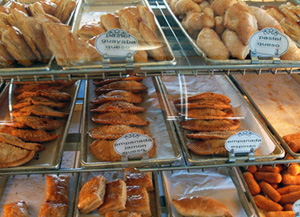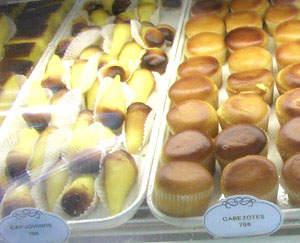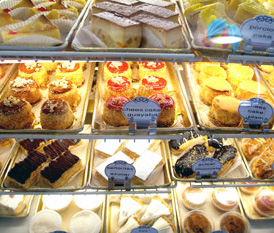Best Cuban Pastries in Miami!






Drinks | Appetizers | Salads | Main Dishes
Soups | Side Dishes | Desserts | Index
Of all the Cuban Pastries, Cubans cherish the pastelito the most. Cubans whose travels have taken them to cities and towns across the United States frequently make pilgrimages back to Miami to savor once again these delicious treats. Pastelitos are similar to an American turnover with a warm and flaky crust surrounding a fruit or meat filling. The most popular and traditional flavors are guava (guayaba), guava and cream cheese (guayaba y queso), coconut (coco), ham (jamón), meat (carne), and cream cheese (queso),. Each type of pastelito has its own shape: guava & cream cheese is triangular like an American turnover, but plain guava is always rectangular. Coconut pastelitos are square, while those stuffed with meat filling are round. Not to be confused with anything else, plain cream cheese comes in a fat cylinder, almost like a twist. (Until you learn the system, you can take heart in knowing that every bakery labels the trays in the store!)
Meringues are similar to the topping of a lemon pie, only drier and puffier. A familiar sight in the checkout lines at Miami grocery stores, the bakery version is fresher and lighter with a crisp outside and slightly gooey center. Some places add a touch of anise to give them a light licorice flavor.
Flan is rich custard, thick with eggs, milk, and cream and baked in a pan coated with dark, caramelized sugar. In the oven, the caramelized sugar liquefies into delicious syrup. Eat flan warm or cold, but always pour this extra syrup over the top. For a real treat, eat it "con coco rallado" with sweetened shredded coconut.
Sink a spoon into Tocinillo de cielo, a close cousin of flan with a sweeter and lighter taste. There are two flavors of tocinillo available at most bakeries: one has a slight lemon-citrus taste, the other tastes like almonds.
One thing in the case that may look familiar is the Cuban version of the croissant. Cangrejos, or crabs (think about the shape of a croissant and you will see how these got their name) are served plain or sometimes baked with a cheese or meat stuffing.
Capuchinos are short yellow thumb-sized cones made with a rich egg yolk-infused cake soaked in a sweet syrup. Panetelas borrachas, (drunken cakes) are similar to capuchinos, but with a round flat shape dunked in a sweet syrup that, depending on the bakery, may or may not contain rum.
The brazo gitano, yes, it actually means Gypsy's arm, is a jelly roll cake filled with sweet guava filling and topped with candied fruits and shredded coconut. Señoritas are flaky pastries filled with layers of creamy custard. Similar to a Napoleon, they come in two flavors: chocolate and vanilla.
Cubans love coconut and coquitos are deliciously sweet coconut candies. They come in several popular varieties: Coquitos blancos, white coconut; Coquitos quemados, toasted coconut; Coquitos melcochados, toasted coconut with a caramel flavor and Coquitos con leche, coconut with milk cream.
The tres leches cake probably came from Nicaragua, but today just about every Cuban restaurant in Miami has it on the menu. The name comes from the "three milks" that are soaked into the cake after baking: sweetened condensed milk, evaporated milk, and heavy cream, making a moist and delicious cake that you can actually eat with a spoon.
Every Cuban bakery has two meat items that are as popular for breakfast as they are for lunch.
Papas rellenas are large balls of mashed potatoes, stuffed with a seasoned meat mixture similar to picadillo, and deep-fried until crunchy and golden brown.
Croquetas are tubes of ground meat and spices that are rolled in crumbs and fried. Usually made of ham or chicken, they are a perfect finger food although many people smash them on a Cuban cracker, saltine, or even a slice of bread—often with a slice of cheese and a thin slice of sweet ham.
Cuban bakeries have a carnival atmosphere with displays of elaborate and colorful birthday cakes, hanging piñatas, and statues and pictures of at least one, and typically all four of the Cuban Saints: Lázaro, Caridad, Regla, and Barbará. If the family has been in the business a long time, there will be a photograph or two of the original bakery back "on the island" in Cuba.
Cake Emborrachado – this cake gets drunk on rum, so you don't have to.
Cake de Guayaba – the sweet guava cake that will remind veteran Cubans of Masa Real.
Croquetas – lightly breaded rolls with great fillings. A favorite at cafe windows all over Miami.
Croquetas de Fufú – what happens when you have a big pile of fufú sitting around YOUR house!
Croquetas de Papas y Jamón – combines the taste of ham with mashed potatoes.
Empanadas – crisp, flaky wedges of pastry surround a filling of ham, beef, chicken and more!
Flan – a wonderfully rich dessert, creamy and full of egg flavor like a very rich custard.
Flan de Coco – coconut is always a fantastic addition to flan!
Flan de Queso – the Cuban version of cheesecake.
Nata Cake Cake squares stuffed with a pudding-like filling and topped with whipped cream.
Pan Cubano A warm, fresh-baked loaf of Cuban bread is the next best thing to heaven.
Pan Medianoche A sweet, eggy bread roll that complements the salty tang of ham and cheese.
Señoritas – flaky pastries filled with layers of creamy chocolate or vanilla.custard.
Merengues – meringues are like the topping of a lemon pie, only drier and puffier.
Papas Rellenas – the fried potato ball with a succulent meat center.
Tocinillo del Cielo – sweeter and lighter than flan, light on the tongue.
Tres Leches Cake – three milks: sweetened condensed, evaporated, and heavy cream.
This new Kindle version contains all of the recipes and editorial copy from the original print edition. As a bonus, the new Kindle edition includes 14 new photos of the prepared dishes.
Use the FREE Kindle Reading App and view our cookbooks on your notepad, tablet, laptop, or computer.
